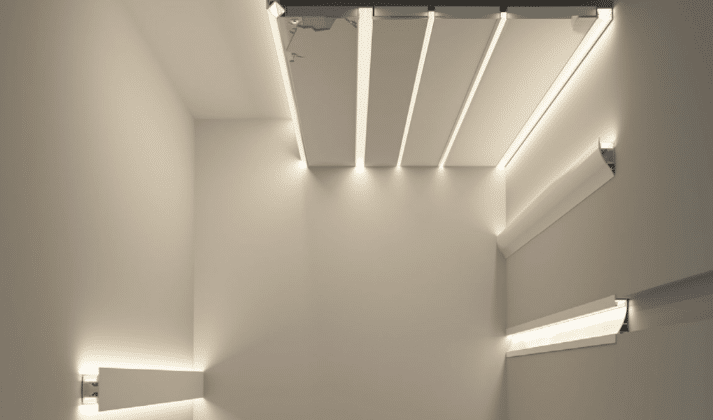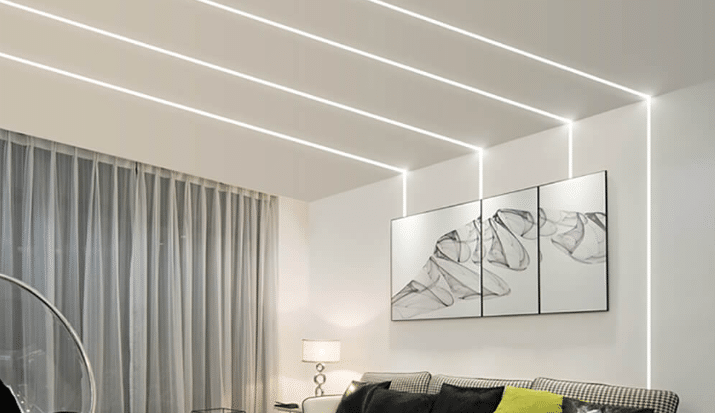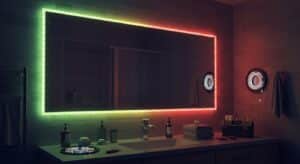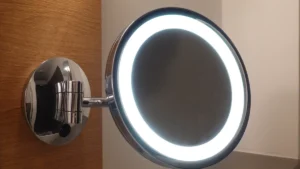
Choosing the best LED strip light profiles and channels is important. These parts protect the lights and enhance their appearance. Diffusers can lower brightness by 30%, providing a softer light. Different LED strip light profiles and channel shapes affect how light spreads. This allows you to adjust the lighting to meet your needs. Understanding these details improves both the performance and aesthetics of your LED lights.
Key Takeaways
Pick shallow channels for small spaces. They look modern and make light softer.
Deep channels spread light evenly. Use them with dense LED strips to avoid bright spots.
Choose a diffuser that fits your needs. Clear diffusers give bright light, while frosted and opal ones make light gentler.
Types of LED Strip Light Profiles and Channels

Shallow Channels
Shallow channels are great when space is tight. They look simple and stylish, perfect for under-cabinet or accent lighting. These channels lower brightness by 22%, giving a softer light. Many people like them for their neat design, especially when the lights are hidden.
Key Benefits:
Small size fits tight areas.
Modern and clean look.
Deep Channels
Deep channels are best for spreading light evenly. They cut brightness by 36%, making the light softer and glare-free. These channels work well with high-density LED strips, removing any bright spots.
Channel Type | LED Density (per meter) | Light Diffusion Performance | Brightness Reduction (%) |
|---|---|---|---|
Deep Channel | 144 | Excellent diffusion | 36 |
Shallow Channel | 144 | Good diffusion | 22 |

Corner Channels
Corner channels fit perfectly into right angles. They are great for kitchens, bathrooms, or spaces with corners. These channels make light flow smoothly and improve the room’s look. They are useful for showing off designs and spreading light better.
Applications:
Lighting under cabinets in kitchens.
Accent lighting in bathrooms.
Recessed Channels
Recessed channels sit inside walls or ceilings for a neat finish. They are popular in modern homes and new buildings. These channels protect the lights and blend well with the design.
Surface-Mounted Channels
Surface-mounted channels are easy to set up and very flexible. They are good for homes and businesses, making LED lights last longer and look better. These channels come in different sizes to suit various needs.
Diffuser Options for LED Strip Lights

Clear Diffusers
Clear diffusers are great for bright and clear lighting. They let most light pass through without blocking it. This makes them perfect for workspaces or display areas needing strong light. They have high clarity and a wide angle for spreading light well.
Performance Highlights:
Brightness: 33,739 lux
Color tone: 2,958 K
CRI: 95
Diffuser Type | Haze Level | Clarity Level | Spread Angle (HVA) | Light Spread Power (LDP) |
|---|---|---|---|---|
Clear | Low | High | Wide | High |
Clear diffusers pair well with shallow channels for a neat look. But they don’t give soft or even lighting for all uses.
Frosted Diffusers
Frosted diffusers balance brightness and soft light. They scatter light to reduce glare and create a gentle glow. These are popular for homes and offices where comfort matters.
Key Metrics:
Medium haze and clarity levels.
Wider angle for better light spread.
Brightness: 23,571 lux (Opal Frosted type).
Frosted diffusers work with both shallow and deep channels. They look polished and keep enough brightness for most needs.
Opal Diffusers
Opal diffusers, also called milky diffusers, spread light evenly. They mix good light transmission with scattering for soft, smooth lighting. These are great for decorative lights or spaces needing no glare.
Diffuser | Brightness (lux) | Color Tone (K) | CRI |
|---|---|---|---|
50% Opal | 27,172 | 2,950 | 95 |
Opal Frosted | 23,571 | 2,995 | 97 |
Opal diffusers work best in deep channels, keeping brightness while spreading light well.
Black Diffusers
Black diffusers hide LED strips when turned off. They absorb more light, making them less bright but stylish. They add a modern look to your lighting setup.
Performance Data:
Brightness: 8,744 lux
Color tone: 2,954 K
CRI: 97
Diffuser | Brightness (lux) | Color Tone (K) | CRI |
|---|---|---|---|
Black | 8,744 | 2,954 | 97 |
Black diffusers are great for accent lighting or hidden setups.

Material Comparison for LED Strip Light Channels
PVC Channels
PVC channels are light and budget-friendly. They work well indoors where strength isn’t crucial. These channels resist water and rust, so they suit damp places. But PVC isn’t as strong as other materials. This makes it less useful in busy or outdoor areas. Adding a diffuser to PVC channels improves lighting and keeps costs low.
PMMA (Acrylic) Channels
PMMA channels, also called acrylic, are very clear. They let 92% of light pass through, making LEDs bright. These channels are light, weighing less than 1.22 g/cm³. This makes them easy to install. They don’t shrink much, so they stay the right size. PMMA channels are great for decorative lights needing high clarity.
Key Features:
Very clear for bright lighting.
Light and keeps its shape.
PC (Polycarbonate) Channels
Polycarbonate channels are super strong and tough. They are 10 times stronger than acrylic and 30 times stronger than glass. This makes them great for outdoor or high-impact areas. They handle heat up to 120 °C, working well in tough conditions. Their clear design helps LED lights shine brightly, making them very useful.
Property | Description |
|---|---|
Durability | Strong and tough, perfect for outdoor use. |
Heat Resistance | Handles heat up to 120 °C. |
Optical Properties | Clear for bright and effective lighting. |
Silicone Channels
Silicone channels are bendable and waterproof. They are perfect for outdoor and curved setups. They resist UV rays and extreme heat, lasting a long time. Silicone protects LED lights in wet or humid places. Their flexibility allows creative designs, ideal for accents and decorations.
Tip: Use silicone channels outdoors or on uneven surfaces for smooth results.
Performance Factors in LED Strip Light Channels
Channel Depth and Light Diffusion
The depth of a channel affects how evenly light spreads. Deep channels spread light better and hide bright spots. They work best with high-density LED strips, like 144 LEDs per meter. At lower densities, like 30 LEDs per meter, dots may still appear. Deep channels reduce brightness by 36%, while shallow ones cut it by 22%. This makes deep channels great for smooth, decorative lighting.
Key Insights:
Deep channels spread light evenly but lower brightness.
Shallow channels keep brightness but may show light spots.
Diffuser Type and Brightness Control
Diffusers change how bright and even the light looks. Clear diffusers are the brightest, reaching 33,739 lux, ideal for workspaces. Opal diffusers soften light, lowering brightness to 23,571 lux. Black diffusers absorb light, giving only 8,744 lux but look modern. Choosing the right diffuser helps you get the lighting effect you want.
Diffuser Type | Lux Level | Light Transmission Rate |
|---|---|---|
Clear | 33,739 | 95% |
Opal Frosted | 23,571 | 50% |
Black | 8,744 | 60% |

LED Density and Uniform Lighting
The number of LEDs per meter affects light smoothness. High-density strips, like 144 LEDs per meter, give even light with no dots. Low-density strips, like 30 LEDs per meter, may show dots even with deep channels. To get smooth light, match LED density with the right channel and diffuser. This balances brightness and smoothness for your project.
Pro Tip: Use high-density strips with deep channels and opal diffusers for smooth lighting.
Heat Dissipation and Material Durability
Good heat control keeps LED lights working longer. Aluminum channels are great at handling heat and stop LEDs from overheating. Overheating can damage LEDs, so aluminum channels help them last. For outdoor or tough areas, polycarbonate channels are strong and heat-resistant. They ensure your lights stay reliable and safe.
Note: Pick materials that manage heat well to make your LEDs last longer.
Recommendations for LED Strip Light Projects
Residential Applications
For homes, LED strip lights are very useful. Shallow channels with frosted diffusers work great in kitchens. They give a soft glow under cabinets, making spaces look nice and useful. Recessed channels are perfect for living rooms or hallways. These lights fit into walls or ceilings for a clean, smooth look. They also keep the lights safe from dust and damage, helping them last longer.
Commercial and Office Spaces
In offices, LED strip lights improve both style and function. Aluminum channels help control heat, making LEDs last longer. Diffusers make the light softer, cutting down on glare and shadows. This creates a more comfortable workspace. These channels match modern office designs, giving a neat and professional feel. Use them for desk lighting or to brighten conference rooms for a better atmosphere.
Decorative and Accent Lighting
For decoration, LED strip lights add a stylish touch. Hidden setups reduce glare, making shelves or under-cabinet areas look better. Aluminum channels and diffusers make the design sleek and polished. They also protect the lights from dust, making them easier to clean and last longer.
Key Benefits:
Less glare for more comfort.
Better looks with smooth finishes.
Protection from dust and dirt.
Outdoor and Waterproof Installations
Outdoor projects need strong and weatherproof options. Silicone channels are great because they bend easily and resist UV rays and heat. For waterproofing, use IP-rated channels. For example:
IP Rating | Best Use | Details |
|---|---|---|
IP44 | Indoors | Works well inside. |
IP55 | Regular Outdoors | Good for most outdoor spaces. |
IP67 | Harsh Outdoors | Best for tough outdoor areas. |
In tough places like cold storage, silicone LED strips work well. They handle temperatures as low as -25°C and resist vibrations, staying reliable.
Picking the right LED strip channel improves lighting and looks. Knowing about diffusers, like clear or opal, helps you choose. Here’s a quick guide:
Diffuser Type | Light Passing (%) | Features |
|---|---|---|
Clear | 95% | Keeps brightness high; LEDs are visible; good for hidden setups. |
Frosted (semi-clear) | 85-90% | Slightly dims light; hides hotspots; covers LED strips well. |
Opal | 75% | Spreads light evenly; stylish when off; fully hides LED strips. |
Think about your project needs to pick the right design and material.
FAQ
What channel type hides LED hotspots the best?
Deep channels are great for hiding LED hotspots. They spread light evenly, especially with high-density LED strips and opal diffusers.
Are LED strip light channels good for outdoor use?
Yes, silicone channels work well outdoors. They are waterproof, resist UV rays, and bend easily. This makes them perfect for bad weather and curved designs.
How can I pick the right diffuser for my project?
Think about your lighting needs. Clear diffusers give bright light. Frosted ones balance brightness and softness. Opal diffusers make light smooth and even. Black diffusers look modern and stylish.
Tip: Pair your diffuser with the right channel and LED density for the best results.



